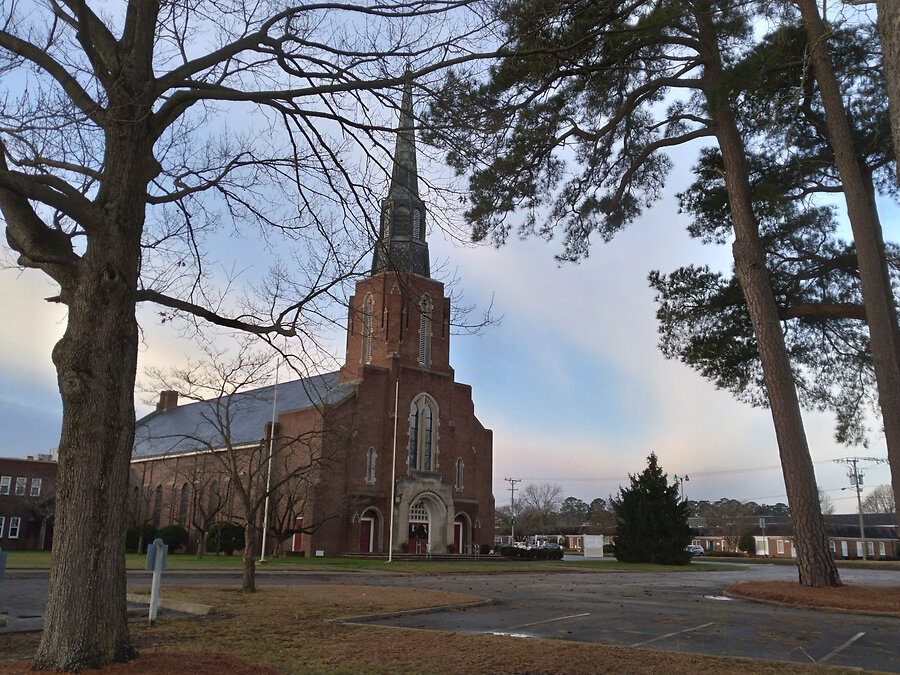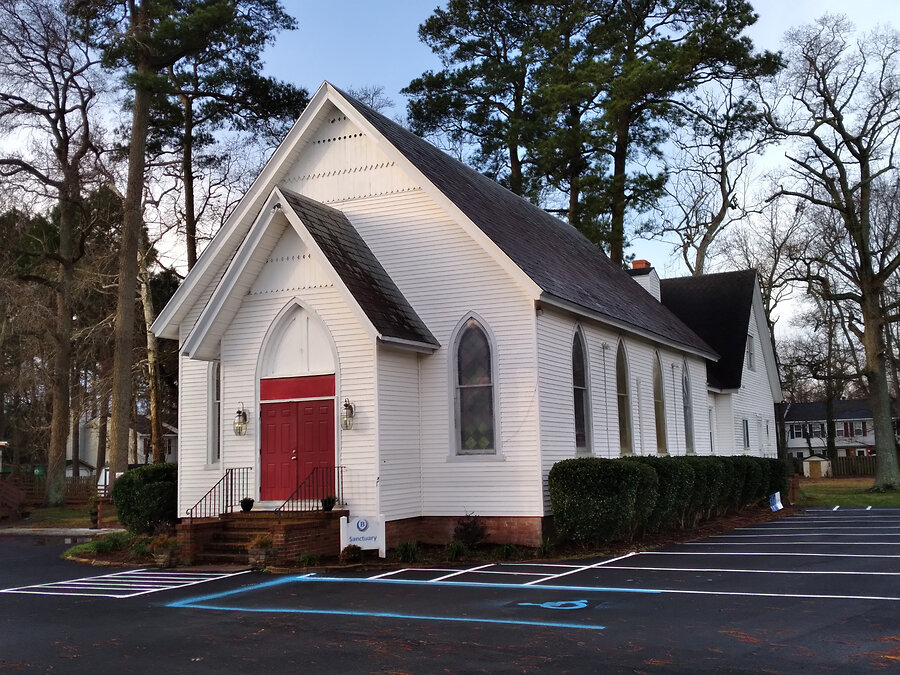 WESTERN BRANCH AND CHURCHLAND Two distinct communities with a shared history spanning centuries by Rob Lauer Early in Virginia's colonial period, English settlers realized that the land along the Elizabeth River's western branch was some of the most fertile in the region. In the 1600s, the King of England granted several favored settlers large swaths of land along the branch's western banks, upon which a number of large plantations soon appeared. During the Colonial period, the primary crop was tobacco. Over the next three centuries, however, as properties were sold off or subdivided among the decedents of the original planters, other crops were introduced. Direct access to the Elizabeth River's Western Branch and the James River to the north made it easy for farmers to transport their goods to other markets. Early planters built wharves along the two rivers from which they transported their produce on "truck boats." With the coming of the railroads in the 1800s, trains stopped at each of the area's inland farms to pick up "truck goods" for markets in Baltimore, Philadelphia, New York, and Boston. Because produce was "trucked" from the area, the farms along the Western Branch became known as "truck farms," and the farmers earned a distinct nickname: "Truckers." Following the Revolutionary War, two of the newest religious movements in America took root in the area. In 1783, during a mission tour from England, famed Methodist Bishop Frances Asbury met with 13 "faithful souls" in the area. Two years later, the congregation had grown large enough to purchase land and build a church-Wesley Chapel-on what is now known as Towne Pointe Road. In the same year, half a mile away, a growing congregation of Baptists established their first church. Because a tiny village of small businesses soon sprang up between these two churches, the area became known as Churchland. The Baptist congregation took on the new name of Churchland Baptist Church. Neighboring Wesley Chapel became Churchland Methodist Church and then Centenary Methodist before moving to their present location on Cedar Lane. The Baptists have remained in the same location for over two centuries.  In 1840, a one-room, wooden structure warmed by a pot-belly stove was built down the road from Churchland Baptist Church to serve as a house of worship for local enslaved people. The congregation adopted the name Grove Church. Because Virginia law at the time prohibited Blacks from assembling without a Caucasian present, white Baptist ministers conducted all services until after the Civil War. With the abolition of slavery, the church called its first African American minister, Reverend Thomas Washington. Today, Grove Church stands in its original location, though it outgrew its original one-room building long ago and is now one of the largest, most vibrant Black churches in Hampton Roads. Headstones in Grove Church's cemetery, dating back to the 1840s, are a testimony of its own rich history as well as that of Churchland. Well into the twentieth century, dirt roads connected Churchland's "truck farms" to the local train depot and the village, with social life revolving around the local churches and schools. Churchland Academy, a small wooden structure built at the end of the nineteenth century, was the area's first school. In 1922, the first Churchland High School was built adjacent to Churchland Baptist Church. The lifestyle in Churchland was decidedly rural. A stable stood next to the original Churchland Academy so that boys coming to school on horseback would have a place to put up their horses while in class. Times being what they were, girls weren't encouraged to go to school on horseback but were carried there in buggies. Many farmers dug large shallow ponds on their land for hosting ice-skating parties during the winter. When automobiles and trucks came into everyday use, driver license regulations in nearby Portsmouth did not extend into Churchland, which was then part of Norfolk County. During those years, it was common to see children driving the family vehicle along the area's dirt roads.  As World War II came to an end and suburbs sprang up across the American landscape, life in Churchland changed quickly. Farmlands were sold and developed into new upscale neighborhoods such as Sterling Point, Cavalier Forest, and Green Meadow Point. Model home developments such as Merrifield made newly built houses affordable for young families. To meet the needs of the growing population, a shopping center, grocery stores, drive-ins, banks, and restaurants were built around what had once been Churchland's tiny village. To accommodate increased traffic, roads were paved. A larger Churchland High School and a new Churchland Elementary School were built in the mid-1950s, while the old 1922 high school became the new home of Churchland Academy. In the 1960s, Churchland Junior High was built on Hawksley Drive, just a mile from the new high school. By the mid-1960s, Churchland-still part of Norfolk County-was one of the most desirable places to live in all of Hampton Roads. The area's growth and popularity triggered what happened next. The neighboring City of Portsmouth and the newly-formed City of Chesapeake both attempted to annex the area, leading to a contentious lawsuit that ended on January 1, 1968. Large portions of Churchland were annexed by Portsmouth; the remaining sections annexed by Chesapeake were named Western Branch. Long-time residents and newcomers who until then thought of themselves as members of one community were now citizens of two different cities. The area's children were most affected by the lines dividing the two new communities. Friends, who had been classmates since first grade, were now separated into two new school systems. Churchland High School became part of Portsmouth Public Schools. Less than a mile away, Churchland Junior High became part of Chesapeake Public Schools, serving first as Western Branch High School and then as Western Branch Middle School. Students whose older siblings had graduated from Churchland High would now graduate from Western Branch High. High school athletes who had once played as teammates now competed directly with one another. The resulting rivalry between the Churchland Truckers and the new Western Branch Bruins was cordial but keenly felt for decades to come, especially during football season. Though the area's business district was primarily in Churchland at the time of the annexations, it soon spread over the city lines into Chesapeake. Nevertheless, Western Branch remained primarily residential until the mid-1980s when Chesapeake Square Mall opened at the intersection of Taylor Road and western Portsmouth Boulevard. Since then, the area has been transformed into a major hub that continues to attract new businesses. Two years ago, Family Medicine Healthcare moved from its original location in the Hodges Ferry area of Portsmouth to a beautiful, new facility one block from the mall. By the late 1990s, the corn and wheat fields along Western Branch's Bruce Road had given way to new neighborhoods and housing developments. Railroad tracks that had run parallel to the road for more than a century were retired, removed, and replaced with paved running trails and park benches. On a typical weekday morning during the school year, students of Western Branch High walk to school along this scenic trail. Throughout the day, residents can be seen walking their dogs, pushing baby strollers, or going for a run. If they follow the trail to the intersection of Bruce and Taylor Roads, they are just a short walk from Midgette Family Dentistry. Founded by Dr. Brian P. Midgette, the practice has been a trusted presence in Western Branch for over thirty years. "Dr. Midgette and I were students at Western Branch High School at the same time," Administrative Assistant Karen DeJesus observes. "We are a true community dental practice-a highly visible part of the local neighborhood. Nearly every patient who steps into our waiting room ends up seeing someone they know." The opening of Highway 664 and the Monitor/Merrimac Bridge during the 1990s made Churchland and Western Branch the center of Hampton Roads. Newport News, Hampton, Olde Towne Portsmouth, and downtown Norfolk are less than 15 minutes away. A 25-minute drive separates the area from downtown Suffolk or Greenbrier, while the Virginia Beach Ocean Front to the east or Colonial Williamsburg to the west can be reached in about 40 minutes.  The area's centrality to the rest of Hampton Roads has attracted businesses and builders from across the region. Recently, Weldenfield and Rowe Custom Homes, one of the region's premier builders of 55-and-better communities, opened its newest, The Retreat at Western Branch on Taylor Road, just minutes off of 664. Beautiful homes designs, a resort-caliber club house with pool, and maintenance-free living make the Retreat ideal for those looking for an active lifestyle in a vibrant, closeknit community. Several years ago, Dr. Michael Keverline, owner of Southside Eyecare, closed his Greenbrier location and consolidated all services to his Churchland office. Patients in Greenbrier and Great Bridge, appreciative of the excellent care offered by Dr. Keverline and his associates, have been perfectly happy to drive a few minutes longer to reach Southside's beautifully spacious Churchland office. A Plus Vinyl and T-Shirts is one of the newest businesses to open in the area. Located on Academy Avenue, A Plus Vinyl sells supplies and equipement so that individuals, community ogranizations, and businesses can create shirts and other paraphernalia bearing their particular logo, brand name, or design. A Plus also offers monthly classses on Cricut-a personal cutting machine. The opening of Highway 664 not only made Churchland and Western Branch easily accessible to the rest of Hampton Roads, but the building of the freeway also changed the area's landscape, giving it a new natural resource. In constructing the earthworks on which the highway was laid, massive amounts of soil were removed from what had formerly been private property, Floral Point Farm in Churchland. The vast crater created by moving the soil eventually filled with water from nearby Hoffler Creek, forming a new body of water, Lake Ballard. Migrating birds and other wildlife were attracted to the area. In 1995, the City of Portsmouth and the newly-formed Hoffler Creek Wildlife Foundation set the lake and its surroundings apart as a wildlife sanctuary and opened it to the public as Hoffler Creek Wildlife Preserve. With walking trails around the lake and through the adjacent woodlands, the stunning beauty of Hoffler Creek attracts hikers, birdwatchers, and nature lovers daily from across the region. The gerrymandering of city lines at the time of the annexation means that even long-time residents have to pay close attention to road signs to keep track of when they are leaving one city and entering the other. A single morning of shopping will have them crossing city lines several times. For instance, Churchland residents (citizens of Portsmouth) have to drive through Western Branch (the City of Chesapeake) for two blocks in order to cross back into Portsmouth and reach the Churchland/Portsmouth Post Office. Business names can also confuse matters. Several businesses with Western Branch in their names are actually located in Churchland (Portsmouth), while others with Churchland in their names are located in Western Branch (Chesapeake.) One year ago, Churchland Cleaners (located in Portsmouth for 33 years) moved a half mile down the road into Chesapeake.Though now technically a Western Branch business, Churchland Cleaners retained it name and its community of devoted customers. One of the historic churches from which Churchland derived its name is another example of this confusion. Because it is the first property on the Chesapeake side of the Chesapeake/Portsmouth city line, Churchland Baptist Church is actually in Western Branch. These oddities from the 1968 annexations are now accepted parts of everyday life. More than 60 years later, Churchland and Western Branch residents have developed a sense of pride in their respective communities while appreciating their shared history. The Shopper 1545 Crossways Blvd. Chesapeake, VA 23320 757-317-5465 http://www.TheShopper.com |